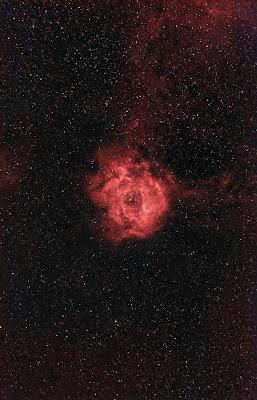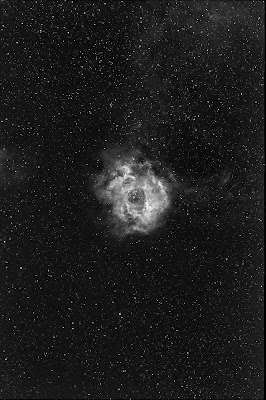COPYRIGHT, PLEASE NOTE
Friday, February 15, 2008
Second light for Canon FD 200mm f2,8 lens


Thursday, February 14, 2008
First light, Canon FD 200mm f2.8 lens
 I added some color, but there was problem with camera orientation, so image is clipped.
I added some color, but there was problem with camera orientation, so image is clipped.
Color data: only 3x600s with UHC-s filter

I shoot California nebula as well. Elevation was very low at the end of the exposures,
only about 28 degrees.
H-alpha 4x900s, same setup.
Color version:
3x600s trough UHC-filter added.
 Over all, I'm veryhappy with this lens. This is very first time to me use camera lens
Over all, I'm veryhappy with this lens. This is very first time to me use camera lens
for astro photography.
I was expecting severe distortion in the image edges, there is none!
I was expecting severe color aberration, there is none!!!
This lens was unexpencive, doe the old FD model, about 120€.
 Here is the link for moreinformation:
http://www.mir.com.my/rb/photography/companies/canon/fdresources/fdlenses/200mm.htm
All the images are shooted with full f2.8 aperature.
Here is the link for moreinformation:
http://www.mir.com.my/rb/photography/companies/canon/fdresources/fdlenses/200mm.htm
All the images are shooted with full f2.8 aperature.
The front lens aperature is 72mm.
FOCUSING Fast lenses are very difficult to focus manually, it's pure luck to reach sharp focus. 200mm f2.8 lens has about 20 microns sharp focus area! I build a simple autofocuser to my lens by using TCF-s temperature compensating focuser. I'll send real pictures about that later. Here is a picture about principle. This system solves allso problems with focus temperature shift!
TCF-s focuser is easy to move back to the main telescope at anytime.
I was able to use FocusMax with the lens and reach sharp focus in 30 seconds.
This system solves allso problems with focus temperature shift!
TCF-s focuser is easy to move back to the main telescope at anytime.
I was able to use FocusMax with the lens and reach sharp focus in 30 seconds.
Thursday, January 31, 2008
Monday, January 28, 2008
IC 1848, start of the project

Thursday, January 24, 2008
IC 1805 core, color added

Sunday, January 20, 2008
Horsehead nebula

Friday, January 18, 2008
Elephant trunk Nebula, reprocessed

Bubble 100% grob from the center part.













